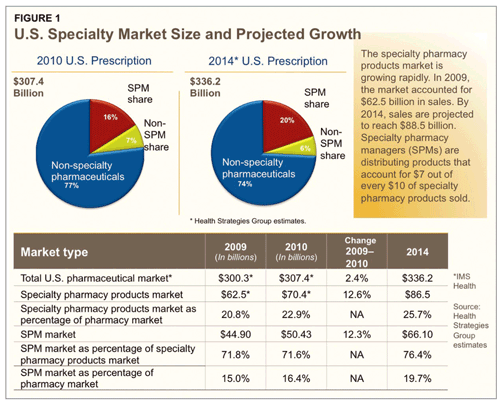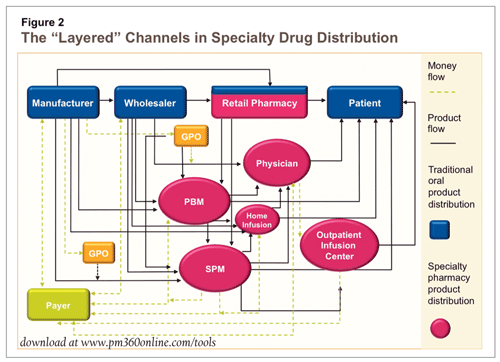During the past five years, specialty pharmacy managers (SPMs) have grown dramatically (Figure 1). Accounting for mergers, acquisitions, and company growth and dissolutions, half of the leading SPM companies have changed and revenues have grown 7- to 10- fold from 2003 to 2009. This alone strongly predicts substantive change in network vendor relationships for payers and companies over the next three to five years. In addition, niche SPMs are emerging, capitalizing on their strength of geographic coverage, physician relationships, disease management expertise, or technological expertise. We estimate that roughly 200 or more SPMs operate within the United States.
For pharmaceutical and biotech companies, SPMs offer challenges as well as opportunities. But before companies can develop a strategy, they must understand the complex specialty products market.
DRIVERS OF SPM GROWTH
SPMs offer substantive opportunities to build greater revenues from existing lines of business, as well as new revenue streams from new technologies and services.
- Specialty products require multichannel delivery, with home infusion a core element.
- Growth in more complex agents increases demand for SPM services.
- The rising demand for outcomes leads to more effective treatment pathways.
- SPMs are now a core tool for managed care transformation and adaptation to healthcare reform.
- There is a national platform to build integrated data systems for more effective patient decision-making.
UNCERTAINTY, COMPLEXITY DRIVE DISTRIBUTION
Even more than other markets, specialty pharmacy is riddled with complexities (Figure 2). The infrastructure that grew up to serve specialty product manufacturers now also serves payers, whose needs are diametrically opposed to pharmaceutical and biotech companies. More important, payers’ needs now loom larger than the manufacturers’. This “layered” nature makes it very difficult for pharmaceutical and biotech companies to track money and product flow.
SPMs have two core customers—pharmaceutical companies and payers—and the services they provide to one often oppose the goals of the other. In a complex juggling act, an SPM may offer services addressing 1) the company’s imperative to build and shift market share, 2) the payer’s mandate to control utilization and cost, and 3) both customers’ needs for the same operational services (but likely with different end purposes).
To succeed in the specialty pharmaceuticals market, companies must consider new lines of distribution. For most outpatient oral and self-injectable products, there are at least six significant —and often interchangeable—distribution channels. As a result, companies risk paying multiple rebates and discounts to distribute and deliver the same drug. Clear contract terms and conditions that address these contingencies are critical.
SPMs’ profit margins have also been shrinking, and many SPMs are looking to pharmaceutical and biotech companies to replace lost revenues through:
- Greater discounts at the point of product acquisition,
- Rebates for performance-based outcomes (including simply sales volumes),
- Fees for services and programs rendered above and beyond standard service activity.
Awareness of these changes and their motivations are critical for companies to understand what SPMs provide to payers as well as to companies themselves.
IMPLICATIONS FOR BIOPHARMACEUTICALS
This state of affairs generates a number of key implications for anyone trying to build an SPM distribution-channel strategy:
- Payers challenging the SPM value proposition and pressing for the lowest common denominator of service could potentially commoditize SPM services.
- Drug-makers must spend time and resources building their products’ value propositions; SPMs can help.
- SPM services can address differentiated “real world” efficacy/outcome data, improved compliance and persistency, outcomes metrics, disease management, and more effective total-cost-of-care management.
- Manufacturers should help their SPM customers build critical methods, provide resources, and demonstrate value.
- Pharma needs to build pathways to alternate-site distribution sources, including home infusion, to minimize challenges to product access.
As the fee-for-service model expands, companies face many complex issues. These might include clarifying what is and is not included in a standard contract, establishing fair-market values for services beyond the standard contract, and demanding SPM performance metrics for individually contracted services.
From the SPMs’ point of view, opportunities for expanding collaborations include options like developing custom payer programs and services to share therapeutic expertise and demonstrate improved patient care, building integrated data systems for more effective prospective management and retrospective outcome metrics, and developing total-cost-of-care or episode-of-care programs that lower care costs overall, achieving operating efficiencies that are more commonly accepted by all stakeholders.
A VOLATILE SEGMENT
Chaos, uncertainty, and wide-ranging stakeholder challenges persist in the specialty segment. Many challenges are arising with few definitive solutions…yet. Complexities already apparent include:
- Appropriate and ethical patient cost-sharing that encourages appropriate self-care decision-making while improving patient outcomes.
- Moving copay and coinsurance collection from physician offices to SPMs, with as-yet-unclear effects on patient demand, accessibility, and overall utilization of specialty products.
- SPMs created by national managed care organizations need to expand beyond their own health plans to achieve sustainability and growth. It is not yet clear that this business model will succeed.
- Fair and reasonable sharing of cost exposure and cost management among all stakeholders.
- Emergence of hospitals and health systems as a driving force in the industry.
These changes imply new distribution and management strategies and tactics between payers, PBMs, and SPMs. Companies should expect both pressure and innovation from SPMs attempting to offer wide distribution and access in a more highly controlled insurance environment. Companies that fail to prepare for these challenges could lose ground, particularly since SPMs account for 70 percent of the specialty pharmacy products market.




